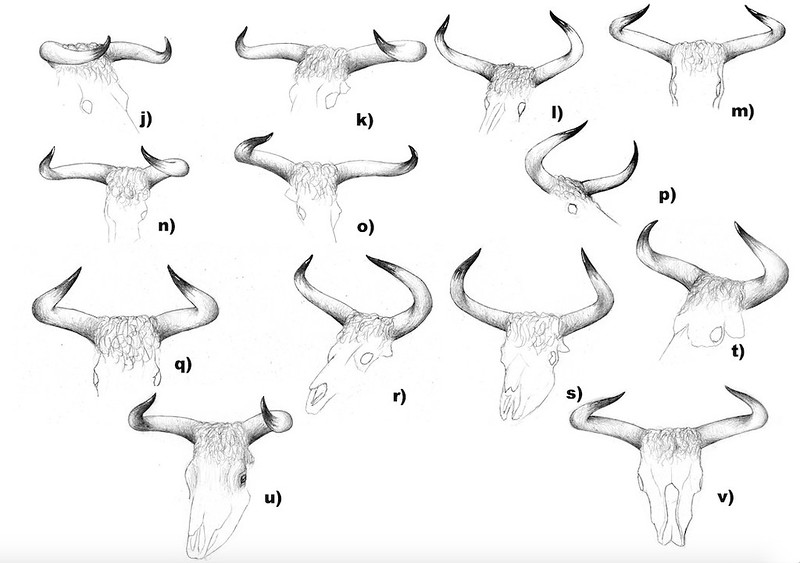Horns are
probably the most wonderful body part of a bovine. Each species has
characteristic horns, and so had the aurochs. An aurochs look-alike would not
be complete if its horns would not resemble their wild ancestors. In order to
breed cattle with authentic aurochs-like horns, one has to know what they
looked like*. This is not problematic, since there are dozens of well-preserved
aurochs skulls with complete or nearly complete horns. But beware that bony
horn cores actually do not represent the actual size and shape of the horn
because the keratinous sheath is missing. That’s why I did a lot of sketches
done by tracking out the original skulls and adding the keratinous sheath. The
sheath continues the spiral-like curve of the bony core and adds about 8% in diameter
and 10-20% in length. Recently I did 22 reconstructions of aurochs horns based on
photos of skull material that I am going to present here.
* For a
detailed description of what the horns of this species were like, go here.
a) Location
and age unknown to me. Rather wide-ranging and large – Pleistocene?
b) Italy,
Pleistocene. Massive horn cores and skull, definitely male.
c) Britain,
age unknown to me.
d) Germany,
age unknown to me.
e) Germany,
age unknown to me.
f) Location
and age unknown to me. Likely male.
g) Germany,
Pleistocene. Really wide-ranging horns.
h) Britain,
Holocene. Likely a cow.
i) Italy,
Pleistocene. Slightly asymmetric. Very likely a cow.
j) Denmark,
early Holocene (Preljerup). Decent inwards-curve. Definitely a bull.
k) Italy,
Pleistocene. Wide-ranging but well-pronounced curve. Likely a male.
l) Austria,
Bronze Age. Wide-ranging. Likely a cow.
m) Germany,
perhaps Holocene.
n) Britain,
Pleistocene. Large specimen with impressive horns. Definitely a male.
o) Denmark,
early Holocene. Wide-ranging, long-snouted à male.
p) Location
unknown to me but perhaps Britain, age unknown to me. Wide-ranging, probably a
cow.
q) Germany,
age unknown to me. Well-pronounced curvature. Probably a bull.
r) Denmark,
perhaps early Holocene. Rather upright and large horns, long skull. Likely a
bull.
s) Denmark,
early Holocene (Vig). Rather upright and weakly curved, long rostrum. Likely a
bull.
t) Location
and age unknown to me. Rather thick cores. Male.
u) Poland,
age unknown to me. Long snout and small orbital openings à male.
v) Poland,
age unknown to me.
It’s
interesting to see the amount of variability regarding horn shapes regarding
orientation relative to the skull, size and how far they curve outwards.
According to Cis van Vuure, the orientation of the horn varies from 50° to 70°
degrees, but using a photo I measured that the horns of the Vig bulls have an
angle of about 80°, and that other bull from Denmark with the upright horns had
probably an even higher angle. But the basic curvature itself is always the
same (see the post linked above). In the sample presented in my drawings you
won’t find a pair of horns that is even remotely lyre-shaped or facing straight
outwards, or any other deviant shape.
I have been
wondering why the horns of the aurochs were that variable. When you look at the
horns of other wild bovines, they are rather stable. OK, the horn sample we
have covers a large geological and geographical scale. But there is no clear
gradient, neither in time or location, so the variability is found within the same population (one
exception: I noticed that southern aurochs had a smaller angle between horns
and snout than northern ones, with those Danish bulls on the one and the oldestAfrican aurochs skull at the other extreme. I assume that this is likely a
result of genetic drift.)
One
explanation could be that the selective pressure on one particular horn type was
not that large as in other bovines, but that argument is not very strong
because the horns of the aurochs were in more active, functional use than those
of gaurs or banteng for example. Another explanation is that the population of
the aurochs increased very rapidly as it spread over Europe and went through
only through little genetic bottlenecks. But this idea does not satisfy me
completely as well.
When you
look at the horns as they are illustrated above, you might notice that some of
them match very well with those of some modern day cattle. A lot of those horns
resemble those of some Watussi and Heck cattle of the Wörth and Neanderthal
lineage. Others also resemble those of a number of Highlands, Barrosa and also
Texas longhorn. And of course, there are those with the “Iberian” type of horns
as well.



No comments:
Post a Comment